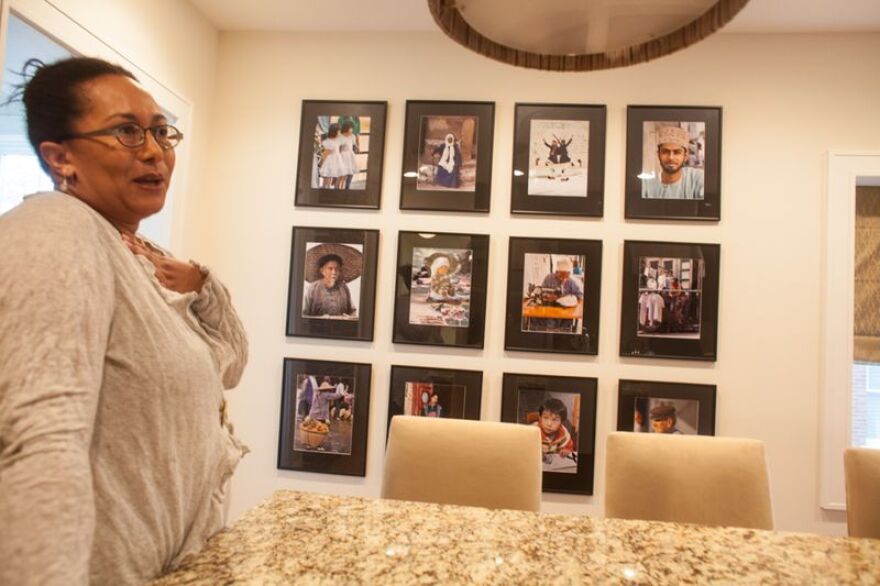This article originally appeared in the St. Louis Beacon. - In her 20s, Adrienne Davis’ focus on race, gender and identity was well defined. Her research as a Yale Law School student and young law professor centered on critical race theory, or the ways in which racism is institutionalized in American society, a theme mirrored by her early art purchases.
“The pieces are very vivid, they have very, very sharp lines, there’s a kind of a definite-ness to them,” Davis said.
Now, at 47, the views of the Washington University law professor and vice provost have become more fluid.
“There’s more ambiguity,” Davis said. “It’s about how law, how culture, how politics regulate identity, and how identity influences law at the same time.”
It’s an evolution that’s evident in her collection, or “collectionette,” as she calls it.
“My thinking has become more capacious, more interrogatory and more complex,” Davis said. “Even the tones that I’m drawn to have become more muted.”
Art over cars
As photographer Jarred Gastreich and I entered the art gallery that is Davis’ 2,100-square-foot Central West End home, she waved us in with one hand, her cell phone in the other, and disappeared around a corner. Momentarily unguided, we took in the many splashes of red, yellow, green and black that pop from pale walls presiding over furniture of neutral tones.

“Hi! I’m so sorry, I was finishing up a little bit of work,” the returning Davis apologized. “This is Bartleby,” she said, introducing the 18-year-old deaf and blind Chihuahua who’s been with her for almost all of her collecting years.
Growing up in Washington, D.C., with one sister, a mother who became an attorney in her mid-40s and an FBI-agent father who enjoyed photography, Davis was always drawn to aesthetics. But her passion for acquiring works of art emerged after her time at Yale, where she earned degrees in Afro-American history, economics and political science before completing law school.
As her work took her to San Francisco, D.C., then North Carolina, she added to her collection, which began with a sand painting by a Nigerian she met on a trip to Paris.
“My friends were buying fancy cars and I would put every spare penny and not-so-spare pennies into art,” Davis said.
In the 1990s, guided by her godmother in D.C., and friend and renowned printmaker Lou Stovall, she expanded little by little. “Pretty Woman,” a painting on canvas by Memphis artist George Hunt that hangs in the library, exemplifies her early acquisitions: vibrant and decidedly African-American. A silkscreen in the living room entitled “Diva,” by Gwendolyn Knight is similarly vivid and iconic.
Bold pigments are also a prominent feature of Sam Gilliam’s hinged acrylic on polypropylene on birch panels, a medium that departs from his usual canvas.
“I love the dimensionality and the colors and that it’s something he did in a very narrow period,” Davis said.
By the living room window, “The Emancipation Approximation” from a series of 27 silk screens by Kara Walker commissioned by Carnegie Mellon, was a more difficult purchase. Because Walker is one of the top African-American female artists and has been a subject of a Davis’ research, Davis wanted to add her to the collection. But Walker’s art -- which inserts the idea of sexual pleasure into the experiences of black victims of white slave-owner brutality -- is naturally, quite controversial.
“I have a love-hate relationship with her work,” Davis said. “I had to find a piece I could feel right about having in my home.”
“The Emancipation Approximation” depicts a classic Southern belle with an axe. Beneath her are numerous, severed heads, some of which appear to be kissing.
“She’s trying to get us to think about slavery through a new lens,” Davis said. “People disagree about what she’s up to, but that’s what the best art does.”
Wire figures to wardrobe pieces
When she relocated to St. Louis in 2008, Davis sought a home suited for displaying her growing collection, which had become more robust after paying off her student loans.
“Art dealers all over the country were very happy,” Davis laughed.

Two local dealers were also pleased to work with Davis: Jim Schmidt and William Shearburn. “I love that Jim and William know me well enough that they’ll call me and say, ‘Hey, I have a piece and I think you’re going to love it.’”
Shearburn’s involvement with Davis has provided him an important education in African-American contemporary art.
“As much as I’ve taught her, she’s taught me,” Shearburn said.
In 2010, Shearburn came upon an abandoned set of wire figures from an unknown Philadelphia artist thought to be an African-American man. Each one contains a piece of late 1960s-early-1970s culture: a gum wrapper, a battery, a nickel.
“I turned her on to these and she just went crazy for them,” Shearburn said.
A few pieces in Davis’ collection came to her through old friends. Her college roommate’s mother, Heide-Marie Evans, is a dressmaker-turned-artist. She made the the robe in which Davis officiated Evans’ daughter’s wedding, as well as two other garments displayed in Davis’ home, some of which she wears on occasion.
“It really challenges the boundary of what is art and what is clothing,” Davis said.
St. Louis gallery
Davis’ evolving focus is readily apparent in her foyer. She calls it her St. Louis gallery, because the pieces were purchased after she moved here. Mostly absent are the vibrant primary colors found in other rooms. They’re replaced by browns and tans such as those of an ephemeral piece by Betye Saar, also a subject of Davis’ writing.

In Saar’s “Passe' Blanc,” a serigraph, the figure is seemingly both over and under the rice paper. The work examines the concept of what the artist calls “interracial intimacy” during and after slavery, and the range of skin tones that resulted.
“It’s this past that sort of haunts us all but yet we can’t quite grasp it,” Davis said.
Another foyer piece is “15 Mouths,” a collection of prints by Lorna Simpson, each featuring a pair of lips. Underneath the mouths is a word, phrase or sentence, such as “sumptuous” or “her vocal chords were taken by the sound of her heartbeat.”
“In the old minstrel shows, black people have big lips and big noses and very, very white eyes, so I love what she's doing with the lips, taking lots of different lips -- men’s, women’s, lots of different races -- and putting them all together, and both deconstructing and reconstructing this idea,” Davis said. “And I also love that the mouth is one of the most intimate parts of ourselves.”
'Hidden' and Heineken
Another recent purchase departs from African-American and slavery themes but focuses on another atrocity: the Holocaust. “Hidden in Plain Sight” is Bunny Burson’s brass-and-aluminum installation, engraved and oxidized, featuring family letters.
Before Burson found the more than 100 pieces of 50-year-old correspondence from her grandparents to her mother, she had no idea her mother was sent from Germany to America at the age of 17 to escape the Holocaust.

Her grandparents’ writing detailed events as mundane as running errands and as urgent as their pursuit of the visas they needed to join her. Tragically, they were murdered before they could reach the U.S. But Burson’s mother never talked about the family story, which has distinct parallels to slavery.
“Slavery was the 19th-century travesty and the Holocaust was the 20th-century one,” Davis said. “And literacy and writing had a role in both of them.”
Another work that’s visually very different from other items in Davis’ collection is a new-media piece by Louis Cameron, called “Heineken.” The new wing of the St. Louis Art Museum houses the same work, a video deconstructing a Heineken bottle.
“I just love that it’s a commentary on pop culture and pushes back at the notion that things in pop culture can’t be beautiful,” Davis said.
When Davis throws a party, “Heineken” always draws a crowd to the library, where it’s displayed.
“It’s hypnotic,” Davis said. “I’ll be in the kitchen and there will be 20 people just staring at it.”
‘If I had to do it all over again’
Amassing a collection is an art in itself. Kevin Haynes, Davis’ friend since law school, who now lives in Houston, said Davis has had fun looking and deciding but she’s never reckless.
“She can be more impulsive and spur-of-the-moment in smaller things but art is very serious for her,” Haynes said. “She’ll follow an artist and become familiar with the work.”

As Davis’ collection has matured, she’s become even more deliberate. “Brood, brood and brood some more” before you buy was the advice of her late friend, St. Louis arts patron Judy Aronson, and Davis paid attention.
“Starting out, I bought whatever I loved,” Davis said. “Now, it’s like, ‘I have these five pieces, what’s a way to enhance the collection?’”
Davis is involved with the Mildred Lane Kemper Museum of Art at Washington University, and much of her life outside academia is within the local art scene. She’s on the board of trustees for Laumeier Sculpture Park and the St. Louis Art Museum. In these and other efforts, she’s also connected with mentors such as SLAM’s Charlotte Eyerman, psychotherapist and renowned collector Helen Kornblum and Emily Pulitzer, who advised her to think beyond her diminishing wall space.
“Emmy said, 'Adrienne, hang things in your bathroom, hang them on your doors,’” Davis said.
Through her associations, her travel and the acquisition of her art, Davis has become a self-taught collector. She’s also discovered a regret, of sorts.
“If I had to do it all over again, I would have majored in art history,” she said. “I may take some classes at Wash U.”
About this series
From time to time, we will take readers into the homes of people who work in visual arts or who have built art collections of note. With the first group, the reader may discover the private tastes and curiosities of those who determine public displays or choose what to offer for sale. The other articles are a chance to glimpse works no longer in the public domain. In all, those who collect will talk about their inspiration and tips for others on their own path of collecting.
Davis’ most recent purchase is two works by emerging female photographer Judy Mauer, who captured the intersection of window mannequins and the reflections of New York buildings. It’s an exploration of gender but not race, illustrating Davis’ ever-shifting focus. As she thinks about the trajectory of her collection, she wonders what’s next.
“I’ll be 48 at the end of the year,” Davis said. “So I’m interested in seeing how my thinking will change in my 50s and if that becomes reflected in my art as well.”
Davis' Tips for Beginning Art Collectors
Spend time at museums, art fairs and galleries to learn what you love
Before buying, "brood, brood, and brood some more" (Judy Aronson)
Develop relationships with dealers and gallerists
Learn how to negotiate; there's always wiggle room
Send questions and comments about this story to feedback@stlpublicradio.org.
Support Local Journalism
St. Louis Public Radio is a non-profit, member-supported, public media organization. Help ensure this news service remains strong and accessible to all with your contribution today.

